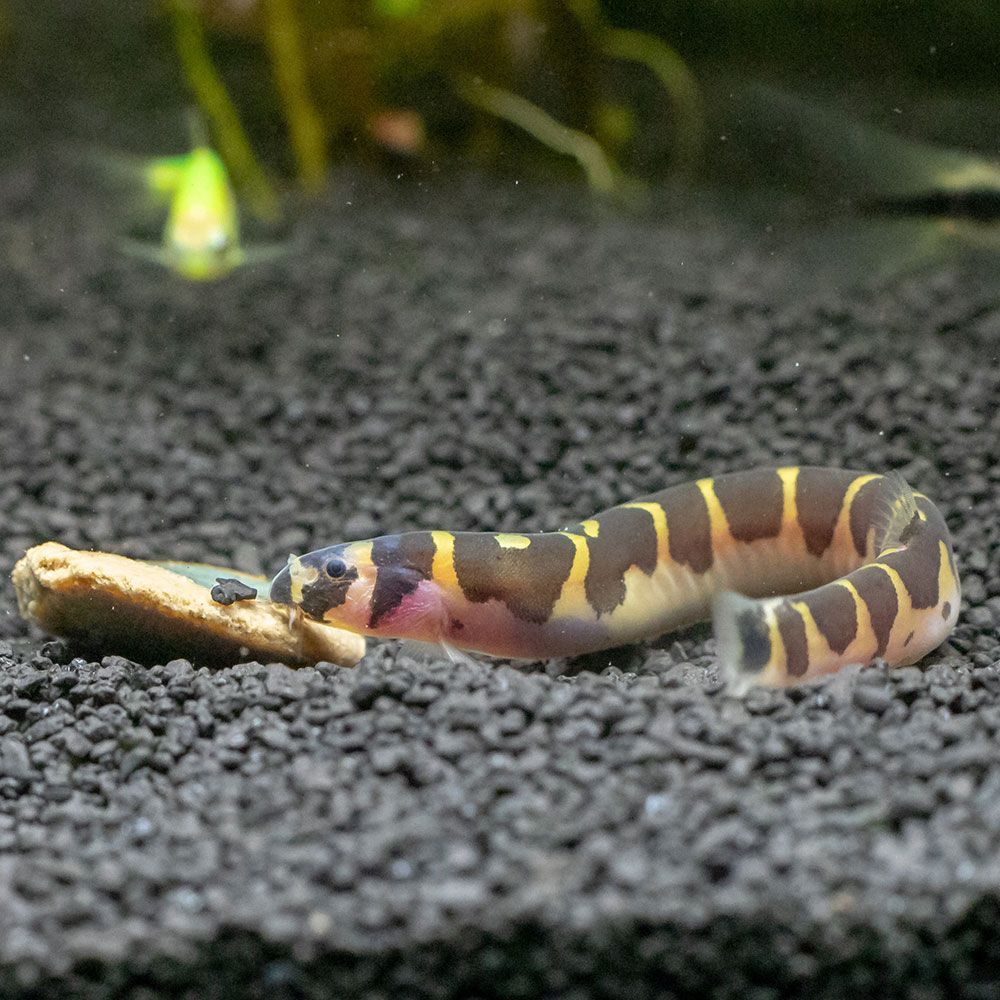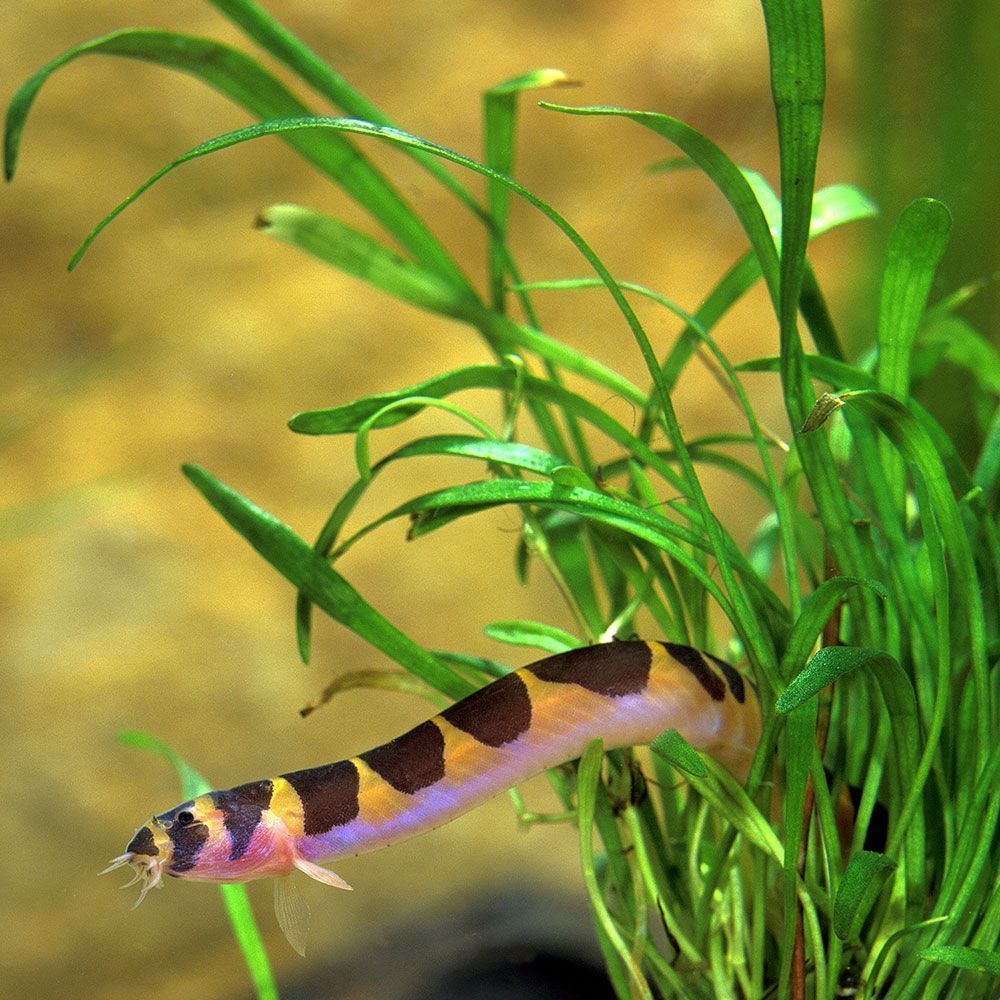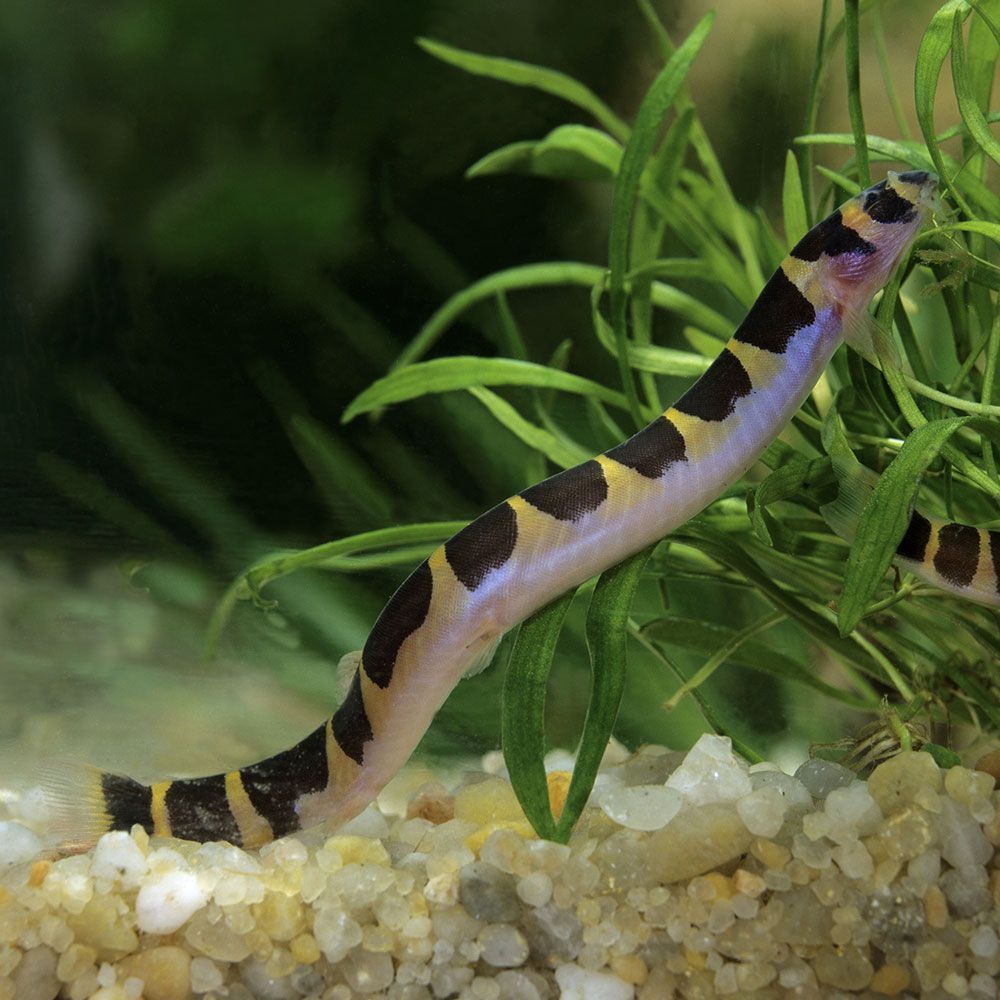The tiger-striped fish has always been an attractive addition to almost any peaceful community tank.
The species also acts as a natural filter, as it cleans any waste from the bottom of the tank. Since it makes no fuss around mealtime, raising it is a treat!
So, if you are curious about this species, keep reading!
What is a Kuhli Loach?
Kuhli loach is a rare-looking freshwater fish which does not even look like a fish and that is the reason of its popularity in the aquarists space.
| Origin | Java island of Indonesia, Peninsular Malaysia and the Great Sunda Islands of Sumatra and Borneo |
| Order | Cypriniformes |
| Family | Cobitidae |
| Scientific Name | Pangio kuhlii |
| Common Names | Kuhli loach, slimy myersi, slimy loach, leopard loach, giant coolie loach, coolie loach, eel loach |
| IUCN Red List Status | Least Concern |
| Appearance | Eel-like long body, slightly compressed sides, striped color pattern with alternate black and yellow and pinkish colors, barbels near the mouth |
| Size | Up to 7.6 cm (3 in) in captivity; up to12.7 cm (5 in) in the wild |
| Lifespan | Generally 10 years, max 16 years |
| Temperament | Peaceful |
| Tank Level | Bottom-dwellers |
| Water Temperature | 75-86 °F (24-30 °C) |
| pH Level | 6-6.5 |
| Water Hardness | Up to 10 dGH |
| Care Level | Easy |
| Minimum Tank Size | 40 gallons |
| Tank Environment | Heavily planted, dimly lit with lots of hiding spaces like rocks, caves, and driftwood. |
| Diet | Omnivorous, scavenger, prefers carnivorous feed |
| Tank Mates | Own group, top and middle dwelling peaceful species |
What is the Natural Habitat of Kuhli Loach?
The kuhli loach originated in the Java island of Indonesia. Currently, it’s widely distributed all over Peninsular Malaysia and the Great Sunda Islands of Sumatra and Borneo.
The fish likes shallow, slow-flowing forest streams or other standstill and calm habitats such as oxbow lakes, swamps, and backwaters.
Though it’s primarily found in clear water, you may also spot it in black water swamps that contain peat. These habitats are usually covered from the sun with dense forest canopies.
According to The IUCN Red List Status of Threatened Species assessment of 2019, this fish was marked Least Concern.
Which Family does Kuhli Loach Belong?
The fish belongs to the Cobitidae family under the Cypriniformes order and is scientifically known as Pangio kuhlii.
This species is recognized worldwide by a few common names, like kuhli loach, slimy myersi, slimy loach, leopard loach, giant coolie loach, coolie loach, and eel loach.
Fun Fact: This fish has an older genus name ‘Acanthophthalmus’, which means ‘thorn’ or ‘prickle-eye’ because of the spinelike barbels under its eyes.
How does Kuhli Loach look?

The kuhli loach has an interesting appearance. Some might say it does not look like a fish at all! Let us tell you all about it.
What is the Size of Kuhli Loach?
The kuhli loach grows quite long – about 7.6 cm (3 in) on average in captivity. The maximum length of this species is 12.7 cm (5 in), which is generally found in the wild.
What is the Color of Kuhli Loach?
The kuhli loach features a color pattern that has pink, yellow, and black to dark brown shades. The body has about 12-17 black or dark brown stripes, and the gaps between these are yellow and pinkish. The lines may go around the entire body or stop at the belly.
This color pattern is similar to that of a tiger. Just as the stripes of every tiger are distinct, there are huge variations in the yellow-black patterns of this same species.
There’s also an albino variant of the kuhli coach aka albino kuhli loach. It’s an artificially bred variant and probably not available in the wild. Otherwise, it would get preyed on pretty soon.
What are the Features of Kuhli Loach?
The kuhli loach is often mistaken as an eel because of its distinct eel-like shape. It also has a slightly compressed, elongated body.
There are four distinct pairs of barbels surrounding the downward mouth. The fish also has a pair of sharp spines which become erect when it feels threatened. This poses a major threat to its predator and becomes a problem while taking the fish out using the net.
Its eyes have a transparent layer of protective skin over them and are also surrounded by a black to dark brown stripe. The head of the fish has no scales.
The dorsal fin is placed past the midpoint of its body. The anal fin is placed at the end of the base of the dorsal fin. All its fins are quite small, and there’s no lateral line.
How do male and female Kuhli Loach differ?
There are very few morphological differences between the male and the female kuhli loach. Hence, it can be very difficult to tell these apart when they are not actively breeding.
However, some subtle differences that are found in the adult males are their muscular upper section and larger and paddle-shaped pectoral fins. The second ray of the adult male fish becomes thick.
The females can become larger when gravid, while the males tend to have more pigmented bodies. In some cases, the green eggs of the female fish are visible through its skin.
What is the Behavior & Temperament of Kuhli Loach?
Kuhli loaches are peaceful towards each other and exhibit very interesting behavior. They don’t attack other tank mates but may consume the eggs and fry of other species.
They like to share their hiding spots, so you’ll often see a pile of this fish in one corner of the tank.
They are bottom-dwelling scavengers that clean up the leftovers of other species. They’re also nocturnal species, so you will only see their activity after sundown.
They’re not particularly schooling species, but they feel more comfortable exploring the aquarium in groups.
What is the Lifespan of Kuhli Loach?
The kuhli loach has a lifespan of 6-10 years, but the maximum it has been recorded to live is 16 years.
Author’s Note: Many kuhli loach varieties are kept by aquarists, like the black kuhli loach, silver kuhli loach, and zipper kuhli loach. These are closely related to each other but not the same species.
How to take care of Kuhli Loach?

If you plan to bring this fish home, you must prepare to provide top-grade care to it. Let us tell you the easiest ways to do it!
What is the Tank Size of Kuhli Loach?
The kuhli loach needs to be kept in groups of 6 fish. Many recommend a 15-20 gallon tank, but a spacious tank will give your loaches more space to thrive.
In my experience, the best option is a 40-gallon tank. Add 3-5 gallons more for each extra fish you add from this species.
What is the Water Chemistry of Kuhli Loach?
To sustain the good health of your kuhli loach fish, you need to maintain the following water parameters:
- pH Levels: 6-6.5
- Water Temperature: 75-86 °F (24-30 °C)
- Water Hardness: Up to 8 dGH
- Carbonate Hardness: Up to 4 dGH
- Ammonia: 0 ppm
- Nitrite: 0 ppm
- Nitrate: Below 20 ppm
What is the Tank Environment for Kuhli Loach?
Next, it’s your job to arrange the best home for your pet fish. To offer it the highest comfort, follow this guide.
Which Substrate does Kuhli Loach like?
The loach likes to burrow in the substrate when frightened. So, use a soft substrate like sand.
You can also use fine 3mm gravel or smooth pebbles. Make sure you check those for any sharp edges before placing them in the tank. Otherwise, they will get injured and even contract diseases.
Which Plants does Kuhli Loach like?
The kuhli loach likes to hide behind plants as it is quite a timid fish. So, a densely planted tank is a must-have. Use live plants to decorate this tank, like peat moss, guppy grass, java fern, cryptocoryne, and so on.
What type of Lighting is needed for Kuhli Loach?
The lighting should be kept subdued, or lots of floating plants should be used to provide shade as it prefers a dimly lit environment. You can, alternatively, place a moonlight in the tank to observe their nighttime activities.
What Décor is needed for Kuhli Loach?
Since the loach prefers hiding places, place decorations like rocks, driftwood, waterworn stones, and caves to give it places to hide and play. You can use almost anything so long there are no sharp edges.
What is the Filtration required for Kuhli Loach?
You can use a canister or powerhead filter in this tank, but make sure to place a mesh on it. Kuhli loaches are known to explore the pipes and small spaces available in the tank. So, they may get sucked into it.
You can use an under-gravel filter as well. This one is a high-oxygenating type and will keep the tank water clean and your loaches healthy. Also, note that your filters have a minimum of 10-15 turnover rate per hour.
What is the Water Flow Rate for Kuhli Loach?
The loach thrives in slow-flowing to still water. So, arrange the water movement accordingly.
Fish Care Tip: The loach tries to enter hollow spaces available in the tank and might get stuck in there. So keep a head count of your loaches, and if you notice a missing member, look for it immediately.
What does Kuhli Loach eat?
The kuhli loach is an omnivorous species that also scavenges, i.e., digs in the substrate and eats leftovers of other tank mates. The fish is also a micropredator that takes substrates in its mouth and gills and searches for larvae and crustaceans.
It also loves to feast on live treats. But it accepts all sorts of food, i.e., flake, wafer, frozen, freeze-dried, and tablets.
Give it a varied diet from the following list to meet its nutritional needs:
- Tubifex
- Glass worms
- Brine shrimp
- Grindal worm
- Daphnia
- Bloodworms
- Vegetables
- Granules
- Fish flakes
- Sinking pellets
- Mosquito larvae
- Blackworms
- Shrimp
- Algae wafers
- Spirulina
- Snails
The fish prefers to eat at nighttime, but you can help them accommodate to daytime meals as well, in a home aquarium.
If you’re having trouble feeding them, try to turn off the lights to replicate the nighttime to ease meal times. Feed it several times a day. Make sure you prepare smaller, sinking food for them.
What are the Tank Mates for Kuhli Loach?
Its ideal tank mate is its own kind, as it likes to live in shoals. If you want to keep other types of fish, consider the following types of fish as tank mates for your kuhli loach:
- Bristlenose catfish
- Corydoras catfish
- Tandanus catfish
- Other catfish
- Danios
- Whiteclouds
- Medakas
- Discus fish
- Eels
- Flying fox fish
- Dwarf gouramis
- Large gouramis
- Gudgeons
- Guppies
- Killifish
- Loaches
- Botia
- Mollies
- Murray cod
- Bristlenose pleco
- Silver and Golden Perch
- Platies
- Rainbowfish
- Harlequin rasboras
- Saratoga
- Sharks
- Silver Dollars
- Shrimps
- Yabbies
- Crabs
- Swordtails
- Tetras
- Endler’s livebearers
Which Tank Mates to Avoid for Kuhli Loach?
Avoid the following types of tankmates to give your kuhli loach a sense of security in its own home:
- Aggressive fish: They’ll intimidate the timid loaches.
- Fin nippers: They will stress your kuhli loach.
- Snails: Kuhli loaches eat snails, so do not house them with snails.
- Bottom dwellers: Kuhli loaches won’t be comfortable because of space crunch.
Some fishes to avoid are:
- Oscars
- Green terror cichlid
- Flowerhorn cichlid
- Red terror cichlid
- Other large cichlids
- Goldfish
- Red-tailed black shark
- Arowanas
- Tiger barbs
- Chinese algae eaters
- Freshwater angelfish
- Blue gouramis
- Bettas
What are the Common Diseases in Kuhli Loach?
The lack of scales on the bodies makes this fish exceptionally susceptible to diseases, especially if the aquarium isn’t cared for. So, you must be aware of all the diseases that can affect your kuhli to get them treatment in time.
| Disease Name | Causes | Symptoms | Treatment |
|---|---|---|---|
| Skinny disease | Parasite infection | A fish is eating well but losing weight | Medication according to their body weight and needs |
| Ich | Protozoan Parasitic Infection | Flashing, noticeable white spots, inactivity, appetite loss | Raise water temperature, add aquarium salts or ich medication, |
| Fin Rot | Bacterial Infection | Fin discoloration or redness, inactivity, appetite loss, fin disintegration, fin fraying | Improve water quality, remove any object that may hurt the fish, add antibiotics according to a vet’s advice |
| Columnaris | Bacterial Infection | Inactivity, appetite loss, fin fraying, white patches | Reduce stress, add antibiotics if a vet advises, enhance water quality |
| Dropsy | Infection, stress, poor water quality | Swollen belly, ulcers, protruding scales, skin redness near fins and vents, | Quarantine, improve diet, regular partial water changes, administer medication |
Quick Tip: Don’t expose the fish to temperatures of 88 °F (31 °C) for too long.
What is the Breeding Process of Kuhli Loach?
Though it is possible to breed kuhli loaches in an aquarium, it’s a bit complicated. So follow what we have to say next to get a good amount of fry.
What is Specimen Conditioning for Kuhli Loach?
This fish is a communal breeder, so the best way to breed them is to keep a large community of them in a tank and maintain normal water conditions. Maintain a male-to-female ratio of 2:1 to have a successful breeding season.
When the loaches are about 2-3 years old, they reach sexual maturity. Provide an abundance of nutritious food like daphnia, tubiflex, and bloodworms to condition them into spawning.
How to Prepare the Breeding Tank for Kuhli Loach?
Prepare a separate breeding tank depending on the number of specimens – at least 30 gallons. Try to mimic the natural environment of this fish.
Use sand, soil, or peat substrate and keep a temperature at the higher end of the range suitable for this fish. Keep the pH around 6.5 or lower and water hardness as low as possible.
Install dim lighting and dense live vegetation to provide them water like the marshes and backwaters it belongs to.
The goal is to recreate the seasons of December to January in its natural habitat.
What is the Mating Process of Kuhli Loach?
When the female fish is ready to lay eggs, she becomes large. The male fish then courts the female to get her attention. He places his head adjacent to hers and secures her under his pectoral fin, which looks like a fish hug. 😉
This pair swims along the tank bottom before moving towards the surface. She lays up to 700 small, green, adhesive eggs that sink to the tank floor or the plants. Each egg looks like it’s enclosed in a bubble nest.
The male externally fertilizes it.
When to Separate Fry from Kuhli Loach Parents?
Kuhli loach doesn’t parent the fry and might eat the eggs, so separate them as soon as the eggs are laid.
When do Kuhli Loach eggs hatch?
Kuhli loach eggs hatch within 1-2 days, and the fry absorbs its yolk sac and becomes free-swimming by the third day.
At this stage, these need small live food, like infusoria, liquid fry food, micro worms, and brine shrimp nauplii. The stripes of the adult fish appear after a month.
After the first seven weeks, introduce the fry to adult kuhli loach food and move these to the adult fish tank.
Breeding Tip: Sprinkle water in the tank three times a day to mimic natural rainfall, as this might encourage this species to spawn.
How to Buy Kuhli Loach?
Don’t buy pale kuhli loach. It signifies that the fish is either stressed or sick.
A word from FishInAquarium
The kuhli loach shows interesting, lively behaviors. During the day, the fish may stay hidden, but after sunset, it burrows throughout the substrate. The fish is also pretty inexpensive and robust, which makes it a low-hassle pet!
So, if this article convinces you to bring the loach home, share this fish fever with others, too! If you have any queries regarding this species, drop us an email, and we will sort it all out for you.


